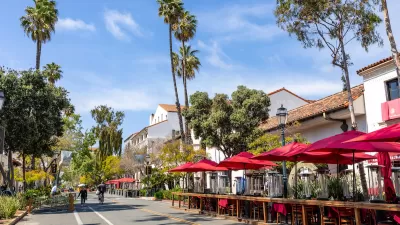A controversy over a massive new dorm proposed for the University of California Santa Barbara, which comes with design strings attached by the donor paying for the new facility, has taken the Internet by storm.

In case you missed the unequivocal champion of viral planning and architecture stories over the past several days, here are the basic facts you'll need to know to catch up: Charles Munger, 97-year-old billionaire and executive at Berkshire Hathaway, has donated the funding necessary to construct a massive new dormitory that would fit 4,500 students on the campus of the University of California, Santa Barbara (UCSB). Munger Hall, as the proposed dorm would be called, would total 1.7 million square feet over 11 stories, with the vast majority of students living in rooms without natural light.
Dennis McFadden, a consulting architect on UCSB’s Design Review Committee, quit in protest of the design, producing a big scoop for Tyler Hayden, who writes for the Santa Barbara Independent. Hayden describes McFadden's letter of resignation as "scorched earth," criticizing the proposed dorm as "unsupportable from my perspective as an architect, a parent, and a human being."
The article from the Independent had legs on social media, and a slew of additional coverage has followed. First, Munger spoke on the record for an article for MarketWatch by Leslie Albrecht, saying he is unfazed by the criticism. Munger also say down for a lengthy, exclusive interview with Fred A. Bernstein for The Architectural Record.
The Munger Hall controversy even reached the pages of the Gray Lady. Maria Cramer sticks to the news in a story for The New York Times, while leaving the design criticism to the words of McFadden, along with statements of support for the project from university officials.
But there is also no shortage of commentary. Included in the ensuing media coverage is a column by Los Angles Times arts, architecture, and urban design critic Carolina A. Miranda, who describes the project as dumber than dumber (dumbest is implied). More specifically, Miranda writes:
The design suffers from a pile-on of deficiencies — among them, a willful, warehouse blandness, limited egress and an extreme density that McFadden likens in his letter to parts of Dhaka, Bangladesh. But the lack of windows in the residential units is perhaps the most glaring problem — especially in light of the pandemic.
Another article by M. Nolan Gray for Bloomberg CityLab places the project in context of the housing stresses facing many students in recent years, with students in Santa Barbara and many other cities living in cars or on the streets while attending university, unable to pay the cost of housing while completing their educations.
McFadden also has a chance to make the case against the project in the Los Angeles Times, contributing an op-ed that cites the New York Tenement House Act of 1901 and the California Building Standards Code in explaining how the project goes wrong.
All of the stories and columns linked above include the news that the university is planning to proceed with the project, as designed, despite McFadden's protest and the criticism of the Internet. McFadden's op-ed points out that the building is not yet fully approved.: the project is still subject to review by the California Coastal Commission and the U.C. Board of Regents.
FULL STORY: Architect Resigns in Protest over UCSB Mega-Dorm

Planetizen Federal Action Tracker
A weekly monitor of how Trump’s orders and actions are impacting planners and planning in America.

DARTSpace Platform Streamlines Dallas TOD Application Process
The Dallas transit agency hopes a shorter permitting timeline will boost transit-oriented development around rail stations.

Congressman Proposes Bill to Rename DC Metro “Trump Train”
The Make Autorail Great Again Act would withhold federal funding to the system until the Washington Metropolitan Area Transit Authority (WMATA), rebrands as the Washington Metropolitan Authority for Greater Access (WMAGA).

Supreme Court Ruling in Pipeline Case Guts Federal Environmental Law
The decision limits the scope of a federal law that mandates extensive environmental impact reviews of energy, infrastructure, and transportation projects.

Texas State Bills to Defund Dallas Transit Die
DART would have seen a 30% service cut, $230M annual losses had the bills survived.

Bikeshare for the Win: Team Pedals to London Cricket Match, Beats Rivals Stuck in Traffic
While their opponents sat in gridlock, England's national cricket team hopped Lime bikes, riding to a 3-0 victory.
Urban Design for Planners 1: Software Tools
This six-course series explores essential urban design concepts using open source software and equips planners with the tools they need to participate fully in the urban design process.
Planning for Universal Design
Learn the tools for implementing Universal Design in planning regulations.
Roanoke Valley-Alleghany Regional Commission
City of Mt Shasta
City of Camden Redevelopment Agency
City of Astoria
Transportation Research & Education Center (TREC) at Portland State University
US High Speed Rail Association
City of Camden Redevelopment Agency
Municipality of Princeton (NJ)





























